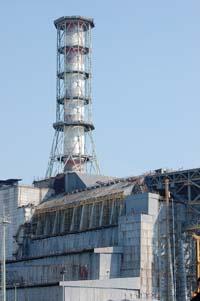Earthquake on the 25th anniversary of the Chernobyl disaster
2011/03/18 Galarraga Aiestaran, Ana - Elhuyar Zientzia
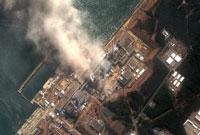
It has been a week since the largest earthquake ever measured in Japan hit the country and, although we do not know what will finally happen in the Daiichi Fukushima Plant, many have already assimilated it to the Chernobyl disaster. In fact, both are not the same, neither at the origin of the accident, nor in subsequent measures, nor in communication. But both have reflected on the same points. As then, discussions have focused mainly on three issues: security, transparency and the future of the nuclear industry.
In addition, the security debate has evolved since March 11, seeing that with the days the situation was increasingly serious. At first, not a few believed that the Fukushima plant had well resisted the damage caused by the earthquake and tsunami, demonstrating that nuclear power plants were safe and prepared to face the risks. In fact, some believe that the Chernobyl disaster involved the development and dissemination of a culture of security. This is, for example, Igor Peñalva, professor at the School of Engineering of the UPV/EHU of Bilbao, in the Department of Nuclear Engineering and Fluid Mechanics.
Peñalva explained that at the time of Chernobyl security was not a priority issue in the Soviet Union, nuclear power plants or other industries. But the incident highlighted the need for security measures.
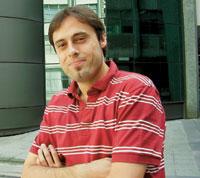
Igor Peñalva is a professor at the Bilbao School of Engineering at UPV in the Department of Nuclear Engineering and Fluid Mechanics. ED. : Ana Galarraga.
To highlight the effectiveness of security measures, Peñalva compared the case of the US central Three Mile Island: "Seven years before the Chernobyl, the US headquarters suffered a similar accident. There the nucleus melted, as happened in Chernobyl. But to a certain extent, the Americans had developed a culture of security whose damage was much lower than those of Chernobyl. It was one of the biggest accidents in nuclear power plants, but no one died, did not get sick, did not cause damage to the environment..."
There is no “zero risk”
The design of the plant was very important because it had such disparate consequences in both cases. Precisely, unlike Western power plants, Chernobyl's reactors had no structure to prevent radioactivity from leaving in the event of an accident. "The Island Three Mile had a confinement structure that prevented the leakage of radioactivity. Now all nuclear power plants have these structures," says Peñalva.
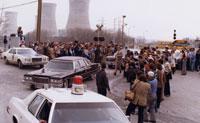
Jimmy Carter, then president of the United States, leaves Three Mile Island after the accident. This accident occurred 7 years before Chernobyl and, although similar, had much milder consequences. ED. : American archive.
Moreover, security measures have been strengthened to the maximum in the nuclear power plants that are now being designed, IV. and generational IV.+. Thus, according to Peñalva, "if an accident occurs in any reactor and can occur because people make mistakes, the system is ready to stop the chain reaction."
However, Peñalva recognizes that “zero risk” is impossible. And that's what Fukushima has shown. In fact, Japanese nuclear power plants were considered one of the safest in the world. And they had to be willing to face the earthquakes and tsunamis that hit the territory, for which they had special measures. According to Peñalva, Fukushima has shown that the measures are "effective": "In short, the failure has not occurred in the reactor, but in the power supply, which has finally led to the failure of the cooling systems, with the consequent danger of melting the reactor cores."
In addition, cracks appear in the confinement structures. "But keep in mind that on the Ritcher scale they have had a 9-degree earthquake, followed by a tsunami. And all the dead that have occurred for the moment have died for that, not for radioactivity."
Options account
However, other nuclear engineers have another perspective, including Dr. José Ramón Etxebarria in engineering. When the Chernobyl disaster occurred, it was in full debate against the construction of the plant in Lemoiz. Now, 25 years later, and although he recognizes that he is no longer so included in the subject, he does not share Peñalva's vision.
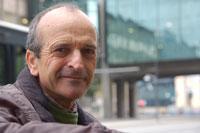
Doctor of Engineering by José Ramón Etxebarria, he has been professor of physics and now teaches Basque at the UPV School of Engineering in Bilbao. ED. Recent searches REVISTA.
Etxebarria believes that the question of security is totally debatable: "In this culture of security they recognize the existence of a risk and then say they are willing to take a risk. But why should we all accept this, how far is a risk acceptable and from where not? The problem is that I don't want to take risks." On the other hand, it questions that security is a priority for the nuclear industry: "Look, if not, at the location of the power plants. Where are they, where have they been? Fukushima is in Japan, where two tectonic plates collide. And across the country they have another 50 nuclear reactors. But Japan is no exception, as many other parts of the world have also become central to unstable areas. There are those from California, who also wanted to do in Chile. In Chile!"
Nor does he agree with Peñalva in the design of the power plants: "There they have also opted. They could choose between making many small plants. It is more expensive, but small plants are safer than large ones, with a single reactor. In Fukushima, however, there are six reactors that have started to fail one after another; if there were one, the problem would be six times less than they have." For Etxebarria, this means that in the execution of the plants they give more importance to the economy than to security. Both Etxebarria and Peñalva have considered it necessary to promote a debate around the possibility of deciding the risk to take.
Transparency in question
In addition to security, the issue of transparency has collected very diverse, often contradictory opinions. Igor Peñalva, for example, believes that this time those responsible have acted with transparency, unlike Chernobil.
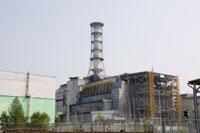
Precisely when the Chernobyl reactor suffered a disaster, its authorities silenced what happened. In two days, however, staff at the Swedish nuclear power plant Forsmark detected radioactive particles in their clothes. At first they thought that the problem was in its central, but by discarding this option they realized that the origin of radioactivity was 1,100 kilometers from there. In Chernobyl.
For Peñalva, this shows that radioactivity cannot be hidden, "and that, from the point of view of transparency, is good," he concluded. "Because the nuclear industry knows this and therefore control is constant." For example, in Europe there is a network that measures the level of radioactivity of the air, "in which we participate," explains Peñalva. "The control station of Bilbao is here, on the roof of the engineering school, there is another in Vitoria, another in Donostia... These are on the Spanish and European networks. Therefore, in case of a minimal leak, we would know immediately, either in Garoña or much further."
He believes that in Japan they have also acted with transparency: "The Fukushima plant has reported with some frequency the status of each reactor, data that are public. The same with the level of radioactivity: they have always reported the level of radioactivity and have adopted the appropriate measures to ensure the safety of the population and workers." José Ramón Etxebarria, however, is insolvent to those responsible and the authorities. "I don't trust myself," he says. "I do not deny the existence of this network and that the people who make the measurements are sincere, but I am sure that if the authorities could have concealed the emission of radioactivity they would have done so, as happened in Chernobil."
In fact, during these days more than one country has accused Japan of hiding or lessening the seriousness of the situation. Thus, on March 14, while Japan said the accident was 4 (on the INES scale, an accident with local effects), the president of the French Nuclear Safety Authority stated that it could be 5-6 (an accident with broad consequences or a serious accident). Two days later, according to the New York Times, the U.S. government concluded that the warnings made by Japanese officials were "scarce" and that they "despised" the danger that was occurring in the reactors, intentionally or involuntarily. Some scientific media have also denounced the concealment of information or at least the lack of communication. For example, in the blog of the scientific journal Nature, on March 14 they published a significant article with the following title: Nuclear test ban agency has valuable radiation monitoring data from Japan nuclear accident -- but can't share them.
Declan Butler is the author of the entry. According to him, the international organization CTBTO is responsible for detecting nuclear bomb tests and measuring the level of radioactivity and other parameters through a global network. Therefore, this organization has also measured the radioactivity escaped from Fukushima, but not having the authorization to make this information public it is not possible to know the data obtained.
The future of the nuclear industry
In the middle of this whirlpool is the nuclear industry. 25 years ago, the Chernobyl accident directly affected the nuclear industry. Some countries, such as Italy, which at the time were considering betting on nuclear energy, retreated. In other cases where power plants already existed, the existing ones continued to function, but no new ones were built. This is what happened in Spain, and although there were other factors, hence Lemoiz's project, according to Peñalva, was suspended. "And the same thing happened throughout Europe, except in France."
But lately the trend was changing. Arguing that nuclear power is the best option to combat climate change, more and more experts and authorities were explaining in favor of this energy source. Thus, before the earthquake in Japan, a total of 53 plants were being built in the world, 142 were planned and 327 proposals. In Europe, for example, the power plants in Italy, Britain, France and Finland were planned or under construction, and outside Europe, many other countries had the same intentions: Brazil, China, United States, India, Argentina...
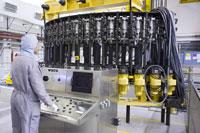
Carrying out a recharge in the central of Santa María de Garoña. ED. : Santa María de Garoña.
In addition, the life of the previously built plants was lengthening in some places, without going further in Garoña. In fact, the life of the plants had a limit of 40 years in Spain, but the Government decided to make an exception with Garoña and decided to close it in July 2013. Then the plant will be 42 years old.
Since the beginning of the year, several agents, including the company that owns the Nuclenor plant, the labor unions of the plant and the mayors of the neighboring towns, were requesting the extension of time, and the Spanish Nuclear Security Council, CSN, noted that, in principle, technical problem to delay the closure until 2019.
Igor Peñalva also does not believe that there are problems to keep going, at least apparently: "I have had the opportunity to get to know Garoña inside and it looks like a central built yesterday. And it's logical, because Nuclenor's intention is to keep running until 2019."
It would be a significant step since the central of Garoña is the oldest in Spain. It is the same type as the central Fukushima, II. generational. Seven others in Spain III. generation and II in France. and III. 58 generation nuclear reactors.
The brake is called Daiichi of Fukushima
However, what is happening in Fukushima has slowed down the expansion of the nuclear industry. The Basque Government, environmental groups and other social agents have already requested the definitive closure of Garoña in 2013. And the Spanish President, José Luis Rodríguez Zapatero, has ordered, in addition to that of Garoña, the review of the security measures of all the plants.
Similar statements have been made by the presidents of other countries of the European Union. Perhaps the most demanding were Angela Merkel, head of Germany. Among other things, March 16 indicated: "We want to enter the era of renewable energy as soon as possible." By then he had already suspended his plan to extend the life of nuclear power plants.
Non-European countries have had similar reactions. For example, China has announced that it will not authorize the construction of new power plants until security standards are revised.

In the United States, President Barack Obama, four days after the earthquake in Japan, called for studies to improve the safety and efficiency of the plants. The next day, however, Energy Secretary Steven Chu requested in Congress a $36 billion loan to boost the U.S. nuclear industry in 2012. It seems, therefore, that the country with more plants does not intend to give up nuclear energy.
In any case, José Ramón Etxebarria and Igor Peñalva agree that Fukushima will be detrimental to the future of the industry. According to Etxebarria, Fukushima has been for them a "slap." Peñalva recognizes it, but also sees the opportunity to be good: "If they finally manage to control the Fukushima plant, the industry can also use its image to clean up and propaganda. In this case, it would be strengthened from this crisis."
In-depth discussion
Time will tell the consequences of the Japanese disaster on the nuclear industry. Etxebarria, however, considers that the "real debate" is another: "For me, the kind of society underlies all this. What kind of society do we want? In today's Western society, the main goal is growth. The good thing is to grow: earn more than last year, be greater than last year. And to grow it is necessary to consume energy. Because we need more and more energy, we also need nuclear energy."
According to Etxebarria, now some are discussing the suitability of this model: "Degrowth is now mentioned by economists and social agents. And I am for it. I have learned that there is no happiness in consumption and that I am happier with another type of life, consuming less energy. So when they say nuclear power plants are essential, I ask them: and why? Do we need energy? I don't, and others think like me."
Peñalva has another opinion: "I think we have to be realistic and to generate a part of the energy we consume, I keep thinking that nuclear energy is a good option."

Gai honi buruzko eduki gehiago
Elhuyarrek garatutako teknologia



